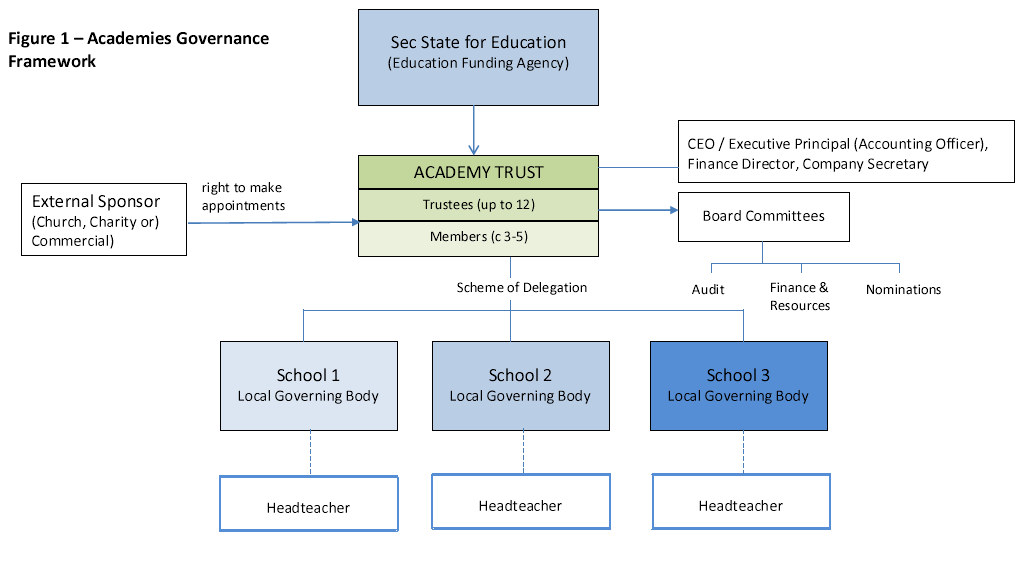This series of posts examines what good governance in academy trusts looks like and how boards can create a framework to deliver their core purpose and properly discharge their duties. In Part 1, we examined the importance of governance and the role of the Board of an academy trust. In this Part 2 we examine..
The framework for good governance in academy trusts
There are now a wide variety of structures used for academy trusts. All Academies are established as independent companies limited by guarantee with exempt charitable status. The following are the usual key players in the structure (see Figure 1):
Members
Members are akin to the shareholders of the company. They have ultimate control over the academy trust, with the ability to appoint or dismiss some or all of the trustees and the right to amend the trust’s articles of association (subject to approval by the Secretary of State). Unfortunately, in many cases the members are often the same people who sit on the board as trustees. This weakens accountability since there is a danger of creating a self-serving oligarchy. Alive to this risk, the Department now recommends that there are at least 5 members, the majority of whom are not trustees. Employees of the trust cannot be members. In most current structures the role of the members is very muted. The members will meet perhaps once a year to approve the accounts and re-appoint auditors. A truly mature model would allow parents, and even pupils, to exercise the full rights of members. For example, the Cooperative Academy model articles provide for pupils, parents, staff, community and alumni to all become members. In theory, they could exercise their powers to dismiss individual directors, or the whole board. For more on the rights of members see here. The Trust must notify the EFA of the appointment of any new members within 14 days.
Trustees
Persons appointed to sit on the board of the academy trust are both company directors and charity trustees. They are responsible for the operation of the trust. They set the strategic direction and are accountable for finance and academic standards. The trustees have duties under charity law to ensure that the academy complies with its governing document and the law, to take reasonable care that the trust is managed efficiently and effectively, and to ensure that resources are used appropriately and protected for the benefit of the charity. They have duties under Company Law to act in the best interests of the company, to avoid conflicts of interest and to perform their duties diligently, as well as wider duties under the general law for the management and safety of premises, safeguarding, data protection, non-discrimination and under employment law. They also have specific contractual duties to the Secretary of State under the Funding Agreement, such as providing information to the Department, providing places to pupils with SEN, providing free school meals and compliance with the Admissions Code, as well as adhering to the Academies Financial Handbook. Trusts must notify the EFA of the appointment of any new trustee within 14 days. The board may establish sub-committees to manage particular strands of its work, such as finance and risk, audit and internal controls, premises and nominations (recruitment & succession planning), curriculum and pastoral care.
Sponsors
Sometimes there may be one or more external sponsor, which could be another high-performing school, a charity, university, commercial organisation or faith organisation. The sponsor may have a right to appoint members and sometimes trustees, which gives them a degree of influence or control. Usually some form of agreement will be in place with the sponsor setting out the scope of their involvement and the terms on which they may receive start-up grant funding. The Department may insist on a ‘tripartite agreement’ which regulates the sponsor’s ability to charge for services only ‘at cost’.
Secretary of State
Despite the rhetoric about academies enjoying a high degree of autonomy, the Secretary of State (through the Education Funding Agency) enjoys very significant controls over academy trust’s freedom of action: firstly, through the Funding Agreement, which provides a wide range of contractual rights for the Department; and secondly, in its capacity as ‘principal regulator’ of an academy’s trust’s compliance with charity law (functions having been asssigned to her under a Memorandum of Understanding with the Charity Commission).
Local Governing Bodies
The role and powers of a local governing body depend on the precise local arrangements. A multi academy trust which runs several schools may devolve powers and functions to a local governing body based on ‘earned autonomy’ (i.e. better performing schools are able to take more decisions locally, whereas others may be purely ‘advisory bodies’). The details about precisely which functions have been delegated by the trust board should be contained in a clear Scheme of Delegation. Local governing bodies may operate as sub-committees of the Board. Key decisions on big ticket issues such as setting vision, policies, governance procedures, contracts and procurement, health and safety, HR matters, the budget and staffing structures usually sit with trustees at the trust board level. There is discretion over whether the local governing body should have any role in:
- determining the individual school’s vision ethos and direction
- recruitment of the Headteacher
- performance management of Headteacher
- delegated responsibility for the budget
The Local Governing Body may have delegated authority in relation to:
- recruitment and performance management of staff, other than the local headteacher
- monitoring of teaching standards
- admissions and exclusions
- Appeals Panels
- term and holiday dates
- reporting to parents
The trust board will usually reserve the right to suspend delegation and intervene in the event of falling standards or a serious risk to welfare of children.
The Department is now considering allowing trusts to either scrap local governing bodies or give them powers to oversee more than one school, with a less prescriptive requirement that the governance of each school should be ‘informed by local intelligence’. This should help remove possible confusion between accountability of local heads and managers to the overall CEO and executive management vs. accountability to local governing bodies. It is important to remember that, even where trustees have given delegated authority for certain functions to local governors or sub-committees, the trustee board as whole remain accountable and responsible for these functions. The ‘buck always stops’ with the board of trustees. It is important that the trust board receives written reports and minutes from sub-committees and local governing body meetings so they have ‘eyes and ears’ on what is happening across the organisation. As the academy trust grows to take in more schools, so the complexity and risk grows: systems and roles may need to evolve. Leaders need to be aware of the organisation’s capabilities and capacity to grow. DfE research (2015) has shown that the key pinch points usually occur when the grouping reaches 5 schools, 11 schools and then 20 schools.
You can read more detail about the governance arrangements and legal duties of trustees of an academy trust in our concise guide.
Getting the documentation right
The main documentation needed to set up the governance framework for an academy trust will include:
- Articles of Association (largely in the form prescribed by the Department with little flexibility to change)
- Funding Agreement(s) with Secretary of State
- Tripartite Agreement with Sponsor and SoS, Letter of Grant, where applicable
- Standing Orders & Financial Regulations, including Tendering and Procurement Policy
- Schedule of Reserved Matters for the Board
- Scheme of Delegation
- Company Registers (Members, Directors, Secretary, Persons with Significant Control)
- Minute Books
- Board Code of Conduct
- Statutory Policies (e.g. Charging, Behaviour, Sex Education, SEN, Data Protection, Complaints, Health & Safety)
- Terms of Reference for Board Committees, such as Audit, Finance, Premises and Nominations.
- Register of Business, Outside Interests & Family connections – which covers members, trustees, local governors and senior leadership team and must be published on the trust’s website
- Conflicts of Interest Policy
- Board Induction, Training and Evaluation Procedures
- Vision, Mission and Values statement
- Strategy Document (see more)
- School Development Plan, including defined KPIs to monitor and measure progress, for example on pupil attainment, quality of teaching, pupil wellbeing, staff morale, effectiveness of communication, future aspirations of pupils.
- (Balanced) Budget
- Risk Register (see more)
- Business Continuity Plan
- Appropriate Insurance Covers
- External auditor appointment letter (setting out their responsibilities)
As the trust grows, there will inevitably be a need for more sophisticated and standardised processes for governance and oversight, including systems for reporting and analysing performance data, financial planning and control, management, HR, teaching and learning methods.
Next time: we look at stewardship of finances and resources.
Mark Johnson is a highly experienced independent solicitor & chartered secretary supporting academy trusts, free schools & other education providers with their governance arrangements, legal and compliance matters. He is an independent member of a MAT audit committee. He offers a cost-effective governance review GovernanceCHECK360™ for academy trusts elderflowerlegal.co.uk.
If you would like to be kept up to date on more topics like this, then why not sign up to receive our regular newsletter.






